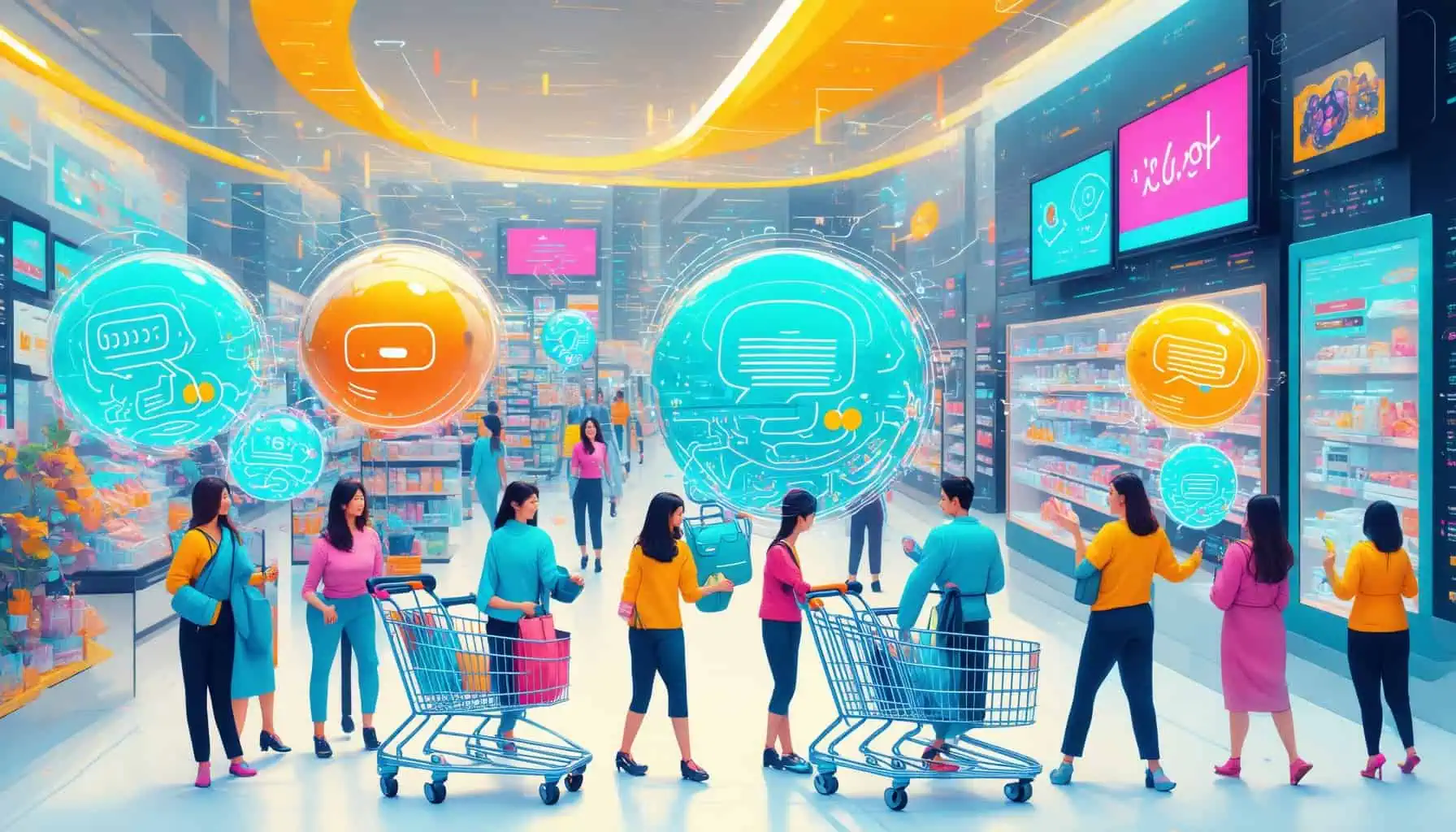Key Takeaways
- 24/7 Customer Support: Ecommerce chatbots provide round-the-clock assistance, enhancing customer satisfaction and retention.
- Personalized Shopping Experience: Utilizing AI, chatbots offer tailored product recommendations, boosting conversion rates significantly.
- Streamlined Checkout Process: Chatbots help guide customers through purchases, reducing cart abandonment and improving sales.
- Efficiency in Handling FAQs: By managing common inquiries, chatbots allow human agents to focus on complex issues, enhancing operational efficiency.
- Proactive Engagement: Chatbots notify customers about promotions and new products, driving traffic and increasing engagement with your brand.
In the rapidly evolving world of online retail, ecommerce chatbots have emerged as a transformative tool, enhancing customer experience and driving sales through innovative AI solutions. This article delves into effective ecommerce chatbot examples that illustrate how these digital assistants can streamline customer interactions, provide instant support, and ultimately boost conversion rates. We will explore whether chatbots can be used for e-commerce, identify the best chatbot for ecommerce, and discuss the four main types of chatbots utilized in the retail sector. Additionally, we will guide you through the process of creating an ecommerce chatbot, integrating AI into your strategy, and highlight industries that benefit most from these technologies. By the end of this article, you will not only understand the various ecommerce chatbots available but also gain insights into best practices and free options to implement on your website. Join us as we uncover the potential of chatbots for ecommerce and how they can revolutionize your online shopping experience.
Can chatbots be used for e-commerce?
Chatbots have become an essential tool in e-commerce, offering numerous benefits that enhance the shopping experience for customers. Here are five key advantages of using chatbots in e-commerce and practical ways to implement them:
- 24/7 Customer Support: Chatbots provide round-the-clock assistance, ensuring that customers can get help at any time. This constant availability can significantly improve customer satisfaction and retention rates. According to a study by HubSpot, 90% of consumers expect an immediate response when they have a customer service question.
- Personalized Shopping Experience: By utilizing artificial intelligence, chatbots can analyze customer behavior and preferences to offer personalized product recommendations. This tailored approach not only enhances user experience but also increases conversion rates. Research from McKinsey shows that personalization can lead to a 10-30% increase in sales.
- Streamlined Checkout Process: Chatbots can guide customers through the purchasing process, helping them find products quickly and efficiently. By integrating with payment systems, chatbots can facilitate a seamless checkout experience, reducing cart abandonment rates. A study by Baymard Institute indicates that 69.57% of online shopping carts are abandoned, often due to complicated checkout processes.
- Handling FAQs and Reducing Workload: Chatbots can efficiently manage frequently asked questions, freeing up human agents to focus on more complex inquiries. This not only improves operational efficiency but also ensures that customers receive quick answers to their queries. According to a report by Salesforce, 69% of consumers prefer chatbots for quick communication.
- Sales and Promotions Notifications: Chatbots can proactively inform customers about ongoing sales, promotions, and new product launches. By sending personalized messages through platforms like Messenger, businesses can engage customers directly and drive traffic to their websites. A study by Facebook found that 53% of people are more likely to shop with a business they can message.
Incorporating chatbots into your e-commerce strategy can significantly enhance customer engagement and drive sales. By leveraging AI technology, businesses can create a more efficient and personalized shopping experience, ultimately leading to increased customer loyalty and revenue. For further insights, refer to sources like HubSpot, McKinsey, and Salesforce, which provide valuable data on the impact of chatbots in the e-commerce landscape.
Overview of e-commerce chatbots and their functionalities
E-commerce chatbots are designed to facilitate interactions between businesses and customers, enhancing the overall shopping experience. These chatbots for e-commerce utilize advanced AI technology to perform various functions, including:
- Automated Customer Interactions: They can handle inquiries, provide product information, and assist with order tracking, ensuring customers receive timely responses.
- Integration with E-commerce Platforms: Many e-commerce chatbots can be integrated with popular platforms like Shopify and WooCommerce, streamlining operations and improving user experience.
- Data Collection and Analysis: Chatbots can gather valuable data on customer preferences and behaviors, allowing businesses to tailor their marketing strategies effectively.
- Multilingual Support: With the ability to communicate in multiple languages, e-commerce chatbots can cater to a global audience, enhancing accessibility and customer satisfaction.
Benefits of using chatbots for customer engagement in e-commerce
The implementation of chatbots in e-commerce offers several advantages that can significantly improve customer engagement:
- Increased Efficiency: Chatbots can handle multiple inquiries simultaneously, reducing wait times and improving customer satisfaction.
- Cost-Effective Solution: By automating routine tasks, businesses can save on labor costs while maintaining high levels of customer service.
- Enhanced User Experience: With personalized interactions and quick responses, chatbots create a more enjoyable shopping experience, leading to higher conversion rates.
- Proactive Customer Engagement: Chatbots can initiate conversations with customers, offering assistance and recommendations based on their browsing behavior.
By leveraging these benefits, businesses can effectively utilize e-commerce chatbots to enhance customer engagement and drive sales growth.

What is the best chatbot for eCommerce?
When considering the best chatbots for eCommerce, several options stand out due to their features, ease of integration, and effectiveness in enhancing customer engagement. Here are some of the top eCommerce chatbot tools:
- Tidio: Tidio combines live chat and chatbot functionalities, allowing businesses to engage with customers in real-time. It offers customizable templates and integrates seamlessly with platforms like Shopify and WooCommerce. According to a study by HubSpot, businesses using chatbots can increase customer satisfaction by 24%.
- Chatfuel: This platform is particularly popular for building Facebook Messenger bots. Chatfuel allows users to create AI-driven chatbots without coding, making it accessible for businesses of all sizes. Research from Juniper Networks indicates that chatbots can save businesses up to 30% in customer service costs.
- ManyChat: ManyChat specializes in Messenger marketing, enabling businesses to automate their marketing campaigns through Facebook Messenger. It provides tools for creating engaging content and personalized customer interactions, which can lead to higher conversion rates.
- Ada: Ada is an AI-powered chatbot that focuses on automating customer support. It allows businesses to create personalized experiences and can handle a large volume of inquiries simultaneously. A report by Gartner suggests that by 2025, 75% of customer service interactions will be powered by AI.
- Snatchbot: Snatchbot offers a versatile platform for building chatbots across various channels, including websites, Facebook Messenger, and SMS. Its user-friendly interface and robust analytics tools help businesses optimize their customer interactions.
Incorporating a chatbot into your eCommerce strategy can significantly enhance customer experience, streamline operations, and ultimately drive sales. For more detailed insights, consider exploring case studies and reviews on platforms like G2 and Capterra, which provide user-generated feedback on these tools.
Features to look for in the best chatbots for eCommerce
When selecting a chatbot for eCommerce, it’s essential to consider several key features that can enhance functionality and user experience:
- Integration Capabilities: The best eCommerce chatbots should integrate seamlessly with existing platforms like Shopify, BigCommerce, and various CRM systems. This ensures a smooth flow of information and enhances customer interactions.
- AI and Machine Learning: Look for chatbots that utilize AI to provide personalized experiences. AI chatbots for eCommerce can learn from customer interactions, improving their responses over time.
- Multilingual Support: As eCommerce expands globally, having a chatbot that can communicate in multiple languages is crucial for reaching a diverse audience. This feature can significantly enhance user engagement.
- Analytics and Reporting: Effective chatbots should offer analytics tools that provide insights into customer behavior and interaction patterns. This data can help businesses optimize their strategies and improve customer satisfaction.
- Customization Options: The ability to customize the chatbot’s appearance and responses is vital for maintaining brand consistency and creating a unique customer experience.
By focusing on these features, businesses can select the best chatbots for eCommerce that not only meet their operational needs but also enhance customer engagement and satisfaction.
What are the 4 types of chatbots?
In the realm of e-commerce, understanding the different types of chatbots is crucial for optimizing customer interactions and enhancing user experience. There are four primary types of chatbots, each serving distinct functions and utilizing different technologies:
- Menu-based Chatbots: These are the simplest form of chatbots, providing users with a predefined set of options to choose from. Users navigate through menus to find the information or service they need. This type is effective for straightforward queries but lacks flexibility in conversation.
- Rule-based Chatbots: Building on the menu-based model, rule-based chatbots employ a decision tree structure. They follow a set of programmed rules to respond to user inputs. For example, if a user asks about store hours, the chatbot will respond based on the specific rules set for that inquiry. While more advanced than menu-based chatbots, they still struggle with complex queries that fall outside their programmed responses.
- AI-powered Chatbots: These chatbots leverage artificial intelligence and natural language processing (NLP) to understand and respond to user queries more dynamically. They learn from interactions and improve over time, making them capable of handling a wider range of questions and providing more personalized responses. AI-powered chatbots can engage in more human-like conversations, making them suitable for customer service and support roles.
- Hybrid Chatbots: Combining the strengths of both rule-based and AI-powered chatbots, hybrid chatbots can switch between scripted responses and AI-driven interactions. This versatility allows them to handle straightforward inquiries efficiently while also managing more complex conversations that require understanding and context.
Use cases for each type of chatbot in the retail sector
Each type of chatbot has unique use cases that can significantly benefit the retail sector:
- Menu-based Chatbots: Ideal for guiding customers through product categories or providing basic information like store hours and return policies.
- Rule-based Chatbots: Useful for handling frequently asked questions and providing specific answers based on user input, such as tracking orders or checking inventory.
- AI-powered Chatbots: Perfect for personalized shopping experiences, these chatbots can recommend products based on user preferences and past purchases, enhancing customer satisfaction.
- Hybrid Chatbots: These can be employed for complex customer service scenarios, where they can address simple inquiries while seamlessly transitioning to AI-driven responses for more intricate issues.
How do I create an eCommerce chatbot?
Creating an eCommerce chatbot involves several key components and steps to ensure effective communication and customer engagement. Here’s a comprehensive guide:
- Define the Purpose: Identify the primary functions of your chatbot, such as customer support, product recommendations, or order tracking. This clarity will guide the design and functionality.
- Choose the Right Platform: Select a platform for your chatbot. Options include website integration, social media channels like Facebook Messenger, or dedicated messaging apps. Facebook Messenger is particularly popular due to its vast user base and integration capabilities.
- Design the Conversation Flow: Map out the conversation paths your chatbot will take. This includes greeting users, answering FAQs, and guiding them through the purchasing process. Use tools like flowcharts to visualize interactions.
- Implement Natural Language Processing (NLP): Utilize Natural Language Understanding (NLU) to interpret user inputs effectively. This allows the chatbot to understand and respond to various customer queries accurately.
- Incorporate Natural Language Generation (NLG): Use NLG to create human-like responses. This enhances user experience by making interactions feel more natural and engaging.
- Set Up Dialog State Tracking: Implement systems to track the context of conversations. This ensures that the chatbot can maintain context and provide relevant responses throughout the interaction.
- Develop a Knowledge Database: Create a comprehensive database that includes product information, FAQs, and troubleshooting guides. This database will serve as the foundation for the chatbot’s responses.
- Integrate with Enterprise Systems: Connect the chatbot with your eCommerce platform, CRM, and other enterprise systems to provide real-time information and streamline operations.
- Test and Optimize: Conduct thorough testing to identify any issues in conversation flow or response accuracy. Use analytics to monitor performance and make data-driven improvements.
- Continuous Learning: Implement machine learning algorithms that allow the chatbot to learn from interactions over time, improving its responses and capabilities.
By following these steps, you can create an effective eCommerce chatbot that enhances customer experience and drives sales. For further reading, consider resources from industry leaders like Shopify and BigCommerce, which provide insights into chatbot development and best practices.
Tools and platforms for building an eCommerce chatbot
When it comes to building an eCommerce chatbot, selecting the right tools and platforms is crucial for success. Here are some of the best options available:
- Messenger Bot: This platform offers a user-friendly interface for creating chatbots that can be integrated into websites and social media channels. With features like automated responses and workflow automation, it’s ideal for enhancing customer engagement.
- Brain Pod AI: Known for its advanced AI capabilities, Brain Pod AI provides a comprehensive suite of tools for developing chatbots. Their multilingual AI chat assistant is particularly useful for reaching diverse audiences.
- Chatfuel: A popular choice for non-technical users, Chatfuel allows businesses to create chatbots for Facebook Messenger without coding. It offers templates and easy integration with eCommerce platforms.
- ManyChat: This platform specializes in marketing automation and allows businesses to build chatbots for Facebook Messenger and SMS. Its drag-and-drop interface simplifies the creation process.
- Zendesk: While primarily a customer service platform, Zendesk offers chatbot functionalities that can be integrated into eCommerce sites, enhancing customer support and engagement.
Choosing the right platform will depend on your specific needs, budget, and technical expertise. By leveraging these tools, you can create a robust eCommerce chatbot that effectively engages customers and drives sales.

How to Integrate AI in eCommerce?
Integrating AI into eCommerce can significantly enhance operational efficiency, customer experience, and sales performance. Here’s a comprehensive guide on how to effectively implement AI in your eCommerce strategy:
Define Your Objectives
Start by establishing clear goals for AI integration. Determine whether you want to improve customer service, personalize shopping experiences, optimize inventory management, or enhance marketing strategies.
Leverage Data Analytics
Utilize your existing data to inform your AI initiatives. Analyze customer behavior, purchasing patterns, and market trends. This data-driven approach will help you identify areas where AI can provide the most value. According to a report by McKinsey, companies that leverage data analytics can improve their profitability by 5-6%.
Implementing AI-powered tools such as chatbots for customer service can streamline interactions and enhance user satisfaction. For instance, our [Messenger Bot](https://messengerbot.app/#features) can handle customer inquiries 24/7, improving response times and customer satisfaction.
Strategies for Integrating AI Chatbots for eCommerce
To maximize the benefits of AI chatbots in your eCommerce operations, consider the following strategies:
1. **Implement AI-Powered Tools**: Consider integrating AI tools such as chatbots for customer service, recommendation engines for personalized shopping experiences, and predictive analytics for inventory management. A study by Juniper Research estimates that chatbots will save businesses over $8 billion annually by 2022.
2. **Personalization**: Use AI algorithms to analyze customer data and deliver personalized product recommendations. This can increase conversion rates and customer loyalty. Research from Epsilon indicates that 80% of consumers are more likely to make a purchase when brands offer personalized experiences.
3. **Optimize Marketing Campaigns**: AI can enhance your marketing efforts by analyzing data to identify the most effective channels and strategies. Use AI to segment your audience and tailor your messaging, ensuring that your marketing campaigns resonate with your target demographic.
4. **Continuous Learning and Improvement**: AI systems learn and adapt over time. Regularly review the performance of your AI initiatives and make adjustments based on analytics and customer feedback. This iterative process will help you stay competitive in the rapidly evolving eCommerce landscape.
5. **Stay Informed on Trends**: Keep up with the latest AI trends and technologies in eCommerce. Resources like Gartner and Forrester provide valuable insights into emerging AI applications that can benefit your business.
By following these steps, you can effectively integrate AI into your eCommerce strategy, driving innovation and enhancing customer satisfaction. For further reading, consult authoritative sources such as the Harvard Business Review and industry reports from Deloitte and PwC, which provide in-depth analyses of AI’s impact on eCommerce.
Which industry uses chatbots the most?
Chatbots have become integral across various sectors, with several industries leveraging their capabilities to enhance customer engagement and streamline operations. The real estate industry is one of the leading sectors utilizing chatbots, providing 24/7 support that allows potential buyers and renters to receive immediate answers to their inquiries, which is crucial in a competitive market. Beyond real estate, numerous other industries are thriving with chatbot integration, including:
- E-commerce: Retailers utilize ecommerce chatbots to assist customers with product recommendations, order tracking, and personalized shopping experiences, significantly improving customer satisfaction and sales conversions.
- Healthcare: Chatbots in healthcare facilitate appointment scheduling, provide medical information, and triage patients, enhancing accessibility and efficiency in patient care.
- Banking and Finance: Financial institutions deploy chatbots for customer service inquiries, transaction alerts, and fraud detection, improving user experience and operational efficiency.
- Travel and Hospitality: Travel companies utilize chatbots to assist with booking processes, provide travel updates, and offer personalized recommendations, enhancing the overall customer journey.
- Education: Educational institutions implement chatbots for student support, answering queries about courses, admissions, and providing learning resources, thus improving student engagement.
- Telecommunications: Telecom companies use chatbots to manage customer service requests, troubleshoot issues, and provide information on plans and services, leading to reduced call center loads.
- Food and Beverage: Restaurants and food delivery services employ chatbots for taking orders, providing menu information, and managing reservations, streamlining operations and enhancing customer interaction.
- Human Resources: HR departments leverage chatbots for recruitment processes, answering employee queries, and onboarding new hires, improving efficiency in managing human capital.
The implementation of chatbots is not only straightforward but also increasingly essential for businesses aiming to enhance customer interaction and operational efficiency. According to a report by Gartner, by 2025, 75% of customer service interactions will be powered by AI, including chatbots, underscoring their growing importance across various industries.
Retail chatbot examples and their impact on sales
In the retail sector, chatbots for ecommerce have proven to be game-changers. For instance, brands like Shopify and BigCommerce offer integrated chatbot solutions that enhance the shopping experience. These e-commerce chatbots can provide personalized product recommendations, assist with cart recovery, and even handle customer inquiries in real-time, leading to increased sales and customer loyalty.
Moreover, the use of AI chatbots for ecommerce allows retailers to analyze customer interactions and preferences, enabling them to tailor marketing strategies effectively. This data-driven approach not only boosts sales but also fosters a more engaging shopping experience, making it easier for customers to find what they need.
Free ecommerce chatbot examples and best practices
In the evolving landscape of online retail, utilizing ecommerce chatbots can significantly enhance customer engagement and streamline operations. Here, we explore some of the best free ecommerce chatbot examples available, along with effective practices for their implementation.
Overview of free chatbot for ecommerce website options
There are several free chatbot for ecommerce solutions that businesses can leverage to improve customer interactions. Notable examples include:
- Chatfuel: This platform allows users to create chatbots for Facebook Messenger without any coding knowledge. It offers a free tier that includes basic functionalities suitable for small businesses.
- ManyChat: Known for its user-friendly interface, ManyChat provides a free plan that supports basic features for building chatbots for shopping on social media platforms.
- Tidio: Tidio combines live chat and chatbot functionalities, offering a free version that helps businesses engage visitors in real-time while automating responses.
- MobileMonkey: This platform offers a free tier that allows businesses to create chatbots for various messaging platforms, enhancing customer service and lead generation.
These ecommerce chatbots not only assist in answering customer queries but also facilitate lead generation and improve overall customer satisfaction.
Best practices for implementing ecommerce chat bots effectively
To maximize the benefits of ecommerce chatbots, consider the following best practices:
- Define clear objectives: Before deploying a chatbot, outline specific goals such as improving customer service, increasing sales, or enhancing user engagement.
- Personalize interactions: Utilize customer data to tailor conversations, making interactions more relevant and engaging. This can significantly enhance the user experience.
- Integrate with existing systems: Ensure your chatbot for ecommerce integrates seamlessly with your CRM and other tools to provide a cohesive experience for both customers and your team.
- Monitor and optimize: Regularly analyze chatbot performance metrics to identify areas for improvement. Adjust responses and workflows based on user feedback and interaction data.
By following these best practices, businesses can effectively implement ecommerce chatbots that not only meet customer needs but also drive sales and improve brand loyalty.




